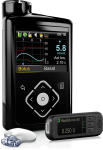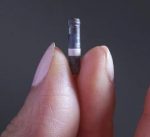Most CGMs (Continuous Glucose Monitors) require calibration by comparing with BG fingerprick samples. These help ensure that the numbers the system reports are a good analog for your current blood glucose. If left uncalibrated for too long the values can drift from reality, but the speed of this drift varies across systems.
I wrote earlier about the effects of calibration and the need for each calibration point to be “good” (sometimes this is referred to as having “good calibration hygiene”) but this post is about how long you can go between calibrations once you’ve got things sorted.
Keep in mind that a good calibration often requires waiting for your BG levels to remain flat for a while (and remain flat while the calibration is processed). Thus you can’t always do this in a rush. In some cases you might have to wait an hour or two for that to happen.
Different CGMs handle calibration reminders in different ways. I’ll talk about these examples:
- Dexcom G5 (managed by official Dexcom apps)
- Dexcom G5 managed by Spike
- Dexcom G5 managed by xDrip+
- Medtronic Guardian2 (640G pump)
- Eversense
Incidentally the Dexcom G6 (which has not yet arrived in Australia) manages to get by without calibrations (although you have the option to calibrate if you want, which is especially useful when extending the life of a sensor).
Both Spike and xDrip+ can also work with Libre sensors (using external Bluetooth scanners such as the MiaoMiao) and in the context of this article my experience with those has been similar to using G5 sensors.
Dexcom G5 (managed by official Dexcom apps)
 The Dexcom G5 wants to be calibrated at least once every 12 hours. If you don’t calibrate within that time it will still report data, but it will give you reminder alarms.
The Dexcom G5 wants to be calibrated at least once every 12 hours. If you don’t calibrate within that time it will still report data, but it will give you reminder alarms.
Note that many people find it still gives useful data days later: as long as the initial calibrations were good it tends to track well for a long time.
Sometimes physical trauma to a CGM sensor site can affect the behaviour, so I’ve found with all these systems it’s worth doing an occasional BG check so you can notice (and sometimes recalibration can cope with the new sensor behaviour). Blindly trusting your CGM for days without checking can sometimes work, but it could occasionally get you into trouble so I try not to make a habit of it. This relates back to Segal’s Law.
G5 managed by Spike
 Spike (a third-party iPhone app) doesn’t use the on-transmitter Dexcom calibration routines, instead using the “raw” data output by the transmitter, and handling the calibration locally.
Spike (a third-party iPhone app) doesn’t use the on-transmitter Dexcom calibration routines, instead using the “raw” data output by the transmitter, and handling the calibration locally.
You can configure the calibration alarm details in lots of ways. Alarm type, frequency, hours, etc. For example you can set it to remind you about the need for calibration only once every 20 hours (since the last calibration) but not during hours that you would be asleep.
Many people find this works very well. You can always calibrate more often if you want, but you can set how long before the system reminds you.
G5 managed by xDrip+
 Like Spike (but running on Android devices) xDrip+ can handle the calibrations locally, and it gives you lots of alarm flexibility. For example I have mine set to not give calibration alarms while the phone is being charged (for me that would usually be because I’m asleep).
Like Spike (but running on Android devices) xDrip+ can handle the calibrations locally, and it gives you lots of alarm flexibility. For example I have mine set to not give calibration alarms while the phone is being charged (for me that would usually be because I’m asleep).
xDrip+ can also use the Dexcom on-transmitter calibration. It does result in calibration alerts after 12 hours, but these are controlled through the same flexible alarm system.
I usually have my xDrip+ CGM set up to use the on-transmitter calibration, and auto-start a new transmitter calibration session every 6 days. It falls back to using the local calibration system during the sensor session warm-up time, so there’s no interruption to the data (although often the final numbers shift by a small step until the new on-transmitter calibration is completed).
Medtronic Guardian2
 The Medtronic Guardian2 (as used on the 640G pump) needs to be calibrated at least once every 12 hours. If you haven’t calibrated by 11 hours, it alarms to remind you. This alarm is quite important:
The Medtronic Guardian2 (as used on the 640G pump) needs to be calibrated at least once every 12 hours. If you haven’t calibrated by 11 hours, it alarms to remind you. This alarm is quite important:
If you don’t calibrate within 12 hours, the system stops reporting data!
I think this limitation fundamentally affects the experience of living with this CGM.
Rather than having to rush a calibration within the last hour (and possibly end up with a bad calibration that throws the system off) it’s usually better to try to calibrate every 8 hours or so (e.g. three times a day) and have room in the schedule to not rush a calibration. Not leaving the calibration to the last minute (e.g. doing them 8-hourly) can also help keep control over a sensor that may be fading and “drifting”.
However, at first when using the Medtronic system I found myself getting on with work and forgetting to calibrate the system until in the late afternoon when I got the 11-hour alarm.
Rather than rushing to calibrate in that last hour you can at least change the alert time. The pump’s Calibrations Reminder feature defaults to 1 hour, but you can configure it to be anything up to 6 hours (thus 6 hours after the last successful calibration). So you might think that setting the reminder to something like 4 hours (thus 8 hours after the last calibration) was a good idea.
However this means that if you do a calibration at 10PM on your way to bed, the system will alert you at 6AM. For me that’s usually before my alarm would go off! I tried setting the reminder to 2 hours (10 hours after the last successful calibration) to allow for this, but not only was this a problem on weekends when I wanted to sleep in, but it also sometimes meant that during the day I got the reminder just after what would have in retrospect been a better time to calibrate.
To cope with this system I think you really need to set up your life around the CGM, probably with regular calibration appointments/reminders in your calendar, at times that better suit each day.
Most of the 640G pump’s alarms can be disabled or modified in some way, although they tend to start out as enabled and this does make the device a bit frustrating. For example the pump’s “SmartGuard” auto-suspend function (driven by the CGM) tends to like to wake you up, even if it’s just to tell you that “normal insulin service” has resumed (although that can be disabled if you look hard enough). I never found a setting for the calibration reminder that suited all times of my days.
Note that the Guardian3 CGM (used by the 670G pump) seems to have identical calibration requirements to that of the Guardian2.
Eversense
 This implanted CGM (not yet available in Australia, but I’ve written about it before) is interesting. It is sometimes described as needing to be calibrated every 12 hours, but in fact it should be calibrated somewhere within the 10-14 hour bracket. If you let it slide and it gets to 16 hours without a calibration, the system will stop reporting data and you need to re-do the initial calibration setup to get it running again.
This implanted CGM (not yet available in Australia, but I’ve written about it before) is interesting. It is sometimes described as needing to be calibrated every 12 hours, but in fact it should be calibrated somewhere within the 10-14 hour bracket. If you let it slide and it gets to 16 hours without a calibration, the system will stop reporting data and you need to re-do the initial calibration setup to get it running again.
I have not tried to live with the Eversense system to be able to comment on how well this would fit into Real Life, but even the addition of that 2-4 hour buffer seems a lot more flexible than the current Medtronic system.
Flexibility is essential!
From a calibration-annoyance point of view, my own experience is that the Dexcom CGM (especially as implemented in xDrip+) is the least-annoying, letting me get on with life and calibrate when convenient, without the CGM either stopping functioning or drifting too far from BG values at the next calibration. The official Dexcom app doesn’t give the same configurability of alarms, but still usually tracks well even days after a calibration.
Alarm and Data Overload?
We hear many different reactions to CGM systems through user experiences. Users of each of these systems seem to include people who love it, and people who hate it. Unfortunately most people have only used one system and can’t compare them. I’ve now used all the above CGM systems (except Eversense) and feel I can make some observations.
I often hear people complaining that CGM systems (along with pumps) are very intrusive. They feel harassed by the alarms/alerts, and sometimes overloaded by the data.
My own first CGM system was using xDrip+, and I never had that experience. I got to configure the alarms the way I wanted, and the CGM was a tool to help me. I’ve also used the other Dexcom-related systems, and overall had similar experiences, although the configurability varies (with the official Dexcom app being the least-configurable).
I couldn’t really empathise with feelings of “alarm overload” from a CGM. Then I used the Medtronic pump for a few weeks.
Now I understand.
A configurable world is a happy world
This is an adage we often refer to in the arena of software development, often from the point of view of a developer or systems administrator.
As a user, when the software that you’re using has to become an integrated part of your life (we wear and depend on these CGMs 24 hours/day) the adage still holds true.
Having to structure your life around artificial limitations decided by a faceless developer is a step backwards. I’m very glad I get to use configurable tools!


Fully agree with your summary at the end, these are tools, and we pay a lot of money to use them. For these to basically rule our lives based on a decision, as you say, by a faceless developer/design team, is a joke
I’ve used dexcom for nearly 4.5 years (nearly at the default end of life of my first g5, rest have been g4), I’m comfortable with the way it works. Though last night I had the first auto restart via xdrip at bloody midnight, why is my tslim pump wanting a double calibration ??